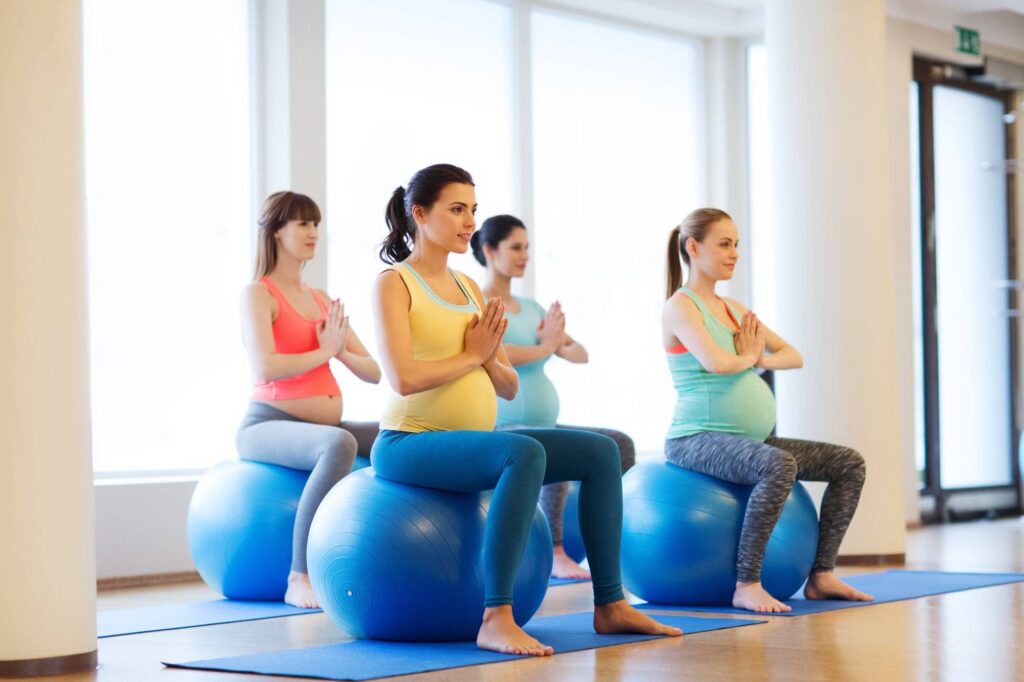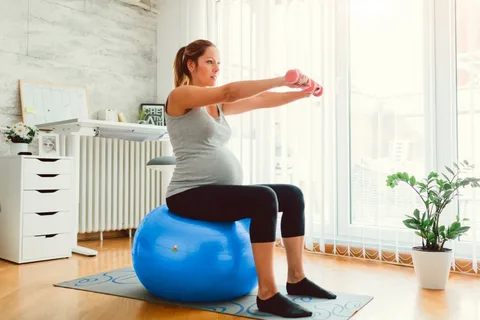The Benefits and Safety of Fitness Ball Exercises for Pregnancy

1. Introduction
Use fitness balls during pregnancy as a means of exercise. Fitness balls are inexpensive, portable, easy to obtain, and versatile, so they may be widely used during pregnancy. Several exercises with fitness balls for pregnancy are described in the proceeding sections. At first, the benefits of fitness ball exercises are reviewed.
Then, safety guidelines for the performance of these exercises are listed. The intention is to provide professionals with a foundation to create fitness programmes using fitness balls for use with their pregnant clients.
With the increasing evidence of the benefits of fitness during pregnancy, the growing popularity of aerobics and exercise classes, and more women seeking advice and support from health and fitness professionals during pregnancy, there is a need for programmes that help pregnant women maintain their physical fitness while ensuring safety for themselves and their developing babies 1.
Interest in fitness ball exercise programmes is also growing. These balls are easy to obtain, inexpensive, portable and versatile. Fitness ball exercises can be performed alone or in groups, indoors or outdoors, at home or at work, and require little space 2. Such attributes may encourage many pregnant women to adopt fitness ball exercises as part of their prenatal fitness programme.
2. The Benefits and Safety of Fitness Ball Exercises for Pregnancy
A fitness ball is a large, inflatable rubber exercise ball used in fitness training to strengthen the deep muscles of the trunk (abdominal and back muscles) and improve posture. Using a fitness ball to exercise while pregnant has become popular recently. These exercises are also referred to as stability ball, balance ball, or exercise ball exercises.
Research has shown that moderate exercise, done regularly during pregnancy, is beneficial. However, some pregnant women may be uncomfortable with land-based exercises or have injury concerns 3. Exercises using a fitness ball can be performed with varying levels of challenge while sitting or lying down on the ball, assisting in the stabilization of the spine and pelvis and the realignment of the spine. These benefits also help to alleviate minor discomforts common to pregnancy.
A fitness ball may be beneficial for overall physical well-being. Research has shown that there are benefits to using a fitness ball during pregnancy. First, using a fitness ball may help improve posture because pregnancy changes a woman’s center of gravity and affects their posture.
Second, using a fitness ball may relieve back pain because the exercises focus on strengthening the para spinal muscles of the torso and lower back 1. Third, fitness ball exercises could be beneficial in labour and delivery. Birth balls are being used in labor rooms to help cope with the pain of labour and for different positions during labour. However, there are some disadvantages and safety concerns associated with fitness ball exercise programmes.
3. Safety Guidelines for Performing Fitness Ball Exercises During Pregnancy

This section focuses on safety guidelines for fitness ball exercises during pregnancy, addressing important questions and facts. Proper techniques for fitness ball exercises will help prevent injuries, and ensuring safety when using fitness balls is essential for a safe practice.
Moreover, special recommended positions to perform these exercises will be addressed, stipulating which common positions may harm both the mother and the fetus. Not only the positions but also the precautions to take during each trimester are included.
Most fitness ball exercises require lying on the back or the stomach for support and are supported by arms or legs. From the 12th week of pregnancy, however, lying on the back, and, after mid-pregnancy, also on the stomach should be avoided 4. Therefore, fitness ball exercises should be adjusted in such a way that the pregnant woman sits on the ball or rests her forearms on the ball while on all fours.
This does not change the characteristics of the exercises. Trunk flexion is a static exercise that causes contractions of abdominal stabilising muscles, and tilting the pelvis forward and backward is a dynamic exercise that involves stabilising and mobilising the lumbar region of the spinal column. Recommended positions. Expectant mothers should be cautious regarding forward flexion and lateral flexion of the trunk while sitting on the ball.
It is more advantageous for a pregnant woman to incline her trunk backward. Perform pelvic motions while sitting on the ball; while tilting the pelvis forward and backward, ensure to sit firmly on the shoulders and lower back without losing contact. Avoid exercises that are deeply bent, forward or lateral flexion, twists, or jerks of the trunk while sitting on fitness balls, especially after mid-pregnancy 5.
4. Incorporating Fitness Ball Exercises into a Prenatal Fitness Routine

Incorporating fitness ball exercises into a prenatal fitness routine can provide numerous benefits to pregnant women. Fitness ball exercises can complement and enhance other prenatal exercises, creating a well-rounded routine that targets different muscle groups and movement patterns.
For example, combining fitness ball exercises with low-impact aerobic exercises, strength training, and flexibility exercises can improve cardiovascular fitness, muscular strength, and range of motion. To incorporate fitness ball exercises into a prenatal fitness routine, pregnant women can start by selecting 2-3 fitness ball exercises that they enjoy and feel comfortable with.
They can then integrate these exercises into their existing workout regimen, performing them 1-2 times a week with a rest day in between. Pregnant women should listen to their bodies and make modifications as needed, such as using a smaller fitness ball or decreasing the range of motion.
To create a comprehensive prenatal fitness routine, pregnant women can follow these guidelines: Begin with a 5–10 minute warm-up to prepare the body for exercise and reduce the risk of injury. This can include gentle movements such as marching in place, arm circles, or shoulder shrugs. Choose a variety of exercises that target different muscle groups, such as upper body, lower body, and core exercises.
Consider including exercises that improve balance and stability, such as standing on one leg or using a balance board. Aim for a total duration of 30-60 minutes for the workout, including both strength and aerobic components. Finish with a 5–10 minute cool-down to help the body transition back to rest and promote recovery.
This can include stretching exercises, such as standing quadriceps stretch or seated forward fold. Pregnant women should consult with their healthcare provider before starting any new exercise programme, especially if they have any medical conditions or complications related to their pregnancy 1.
Read more: The Ultimate Guide to Exercise Dress Comfort Style and Performance
References:
1. Gordon C. Exercise and pregnancy: information for practice nurses. 2019. [PDF]
2. Alnaeem L, S Alkulaib S, J Alatiyyah Z, R Alrashed N et al. Pregnant Women’s Knowledge, Attitudes, and Associated Factors Towards Physical Exercise During Pregnancy in Al-Ahsa City, KSA. 2024. ncbi.nlm.nih.gov
3. Anne Ou27 Hanlon Smith S. THE EFFECTS OF AN AQUATIC INTERVENTION PROGRAMME ON THE DISCOMFORTS OF PREGNANCY. 2002. [PDF]
4. Korabiusz K, Wawryków A, Fabian-Danielewska A, Stecko M et al. Physical activity of pregnant women. 2018. [PDF]
5. Rodrigues-Denize N, Tara Rava Zolnikov B, Furio F. A systematic review on the physical, mental, and occupational effects of exercise on pregnant women. 2024. ncbi.nlm.nih.gov